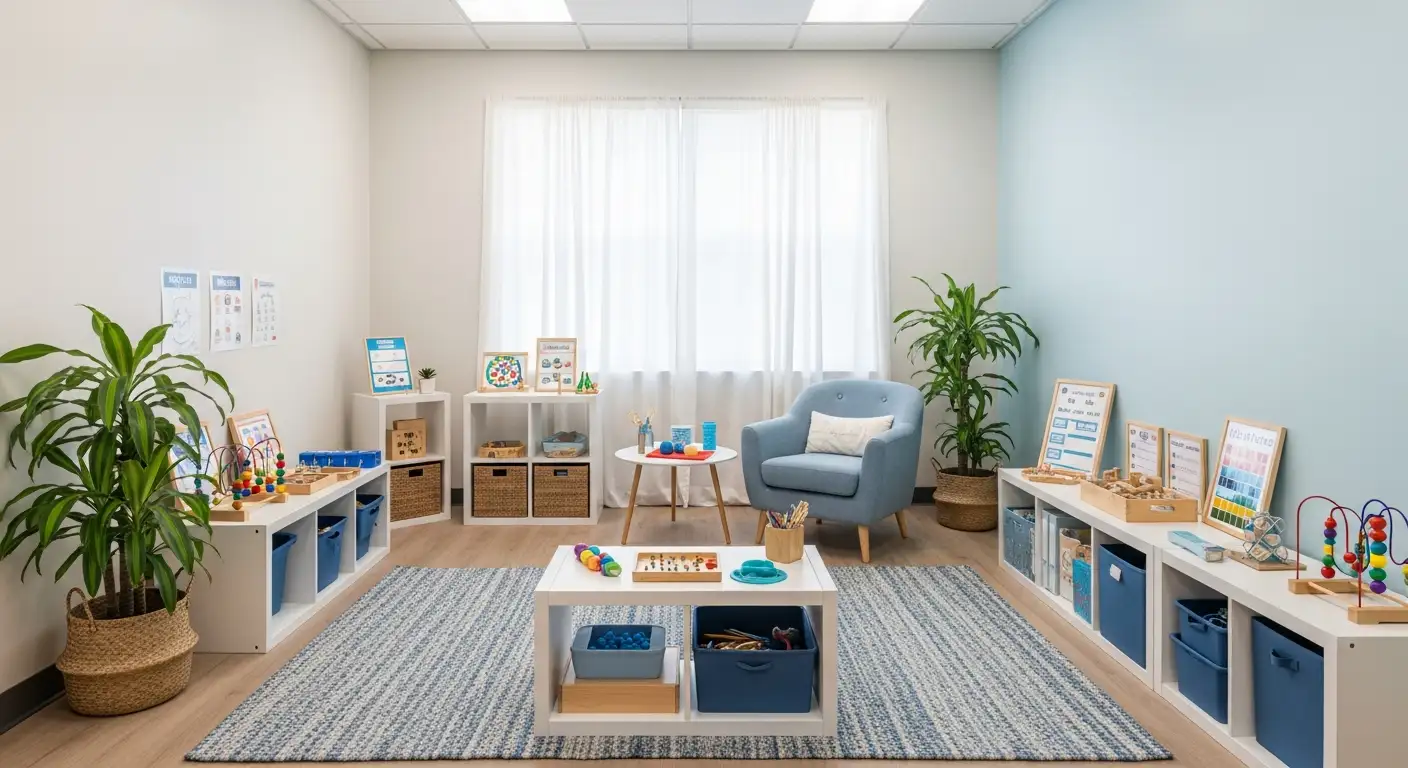Understanding Motor Skills in ASD
In the context of autism spectrum disorder (ASD), motor skills often extend beyond basic physical capabilities. They play a significant role in the social development of individuals with ASD and can impact their ability to interact with their environment and others effectively. Research has revealed intriguing links between motor and social skills in individuals with ASD, highlighting the potential for early interventions targeting motor skills to improve social outcomes.

Link Between Motor and Social Skills
A comprehensive review of 16 studies by NCBI found that 12 of them reported associations between social and motor skills in individuals with ASD. Interestingly, among the different types of motor skills, fine motor skills showed a stronger relationship with social skills compared to gross motor skills.
Among the gross motor skills, object control skills were closely linked to social skills. Among fine motor skills, manual dexterity was most closely related to social skills. This suggests that certain specific motor skills might have a more significant impact on social abilities in individuals with ASD.
Further research has indicated that early motor delays might aid in the early diagnosis of ASD. Additionally, interventions targeting motor skill impairments could potentially improve later social skills problems in individuals with ASD. Particularly, object control skills and manual dexterity might be instrumental in enhancing social skills.
These findings underscore the importance of viewing motor skills not just as physical capabilities, but as crucial components in the broader developmental landscape of individuals with ASD. The relationship between motor skills and social skills in individuals with ASD may be key to unlocking new strategies for interventions and support. However, more longitudinal research is needed to fully understand if there is a causal relationship between these skills.
Importance of Early Motor Development
In the context of autism and motor skills, early motor development holds a significant place. A growing body of literature suggests the presence of early impairments in the motor development of children with autism spectrum disorder (ASD). These early motor impairments can often be recognized even before the emergence of the classical social communication deficits of autism. This makes understanding early motor development crucial in ASD.
Early Signs of Motor Impairments
Motor impairments are significant in ASD as they can serve as early clinical markers. These impairments may contribute to the development of social communication deficits in children with ASD. Early motor dysfunction can manifest as a delay in motor development or atypicalities of motor development.
Studies reveal that children with ASD may exhibit a delay in acquiring gross and/or fine motor abilities during the first year of life. These delays can include a delayed age of acquisition of sitting without support, standing without support, and walking alone. Furthermore, children who later receive an ASD diagnosis may already show differences in fine motor skills and communication skills as early as 6 months of age.
It's imperative to note that early motor dysfunction in children with ASD may not be exclusive to ASD. It can also be present in other neurodevelopmental disorders. Studies have shown that children with neurodevelopmental disorders, including ASD, may exhibit delays in motor domains as early as 12 months of life or even earlier [1].
The presence of motor signs in high-risk infants, even before the onset of social communication deficits, can serve as a relevant warning signal for the imminent appearance of an ASD clinical picture. Therefore, early detection of motor signs in high-risk individuals, even in the absence of social communication deficits, is crucial for timely diagnosis and intervention [1].
Understanding these early signs of motor impairments is critical in the context of autism and motor skills, as it can guide early interventions and lead to better outcomes for children with ASD.
Impact of Motor Deficits on ASD
Understanding the relationship between motor skills and Autism Spectrum Disorder (ASD) can provide valuable insights into the developmental challenges faced by individuals with ASD.
Motor Dysfunction and Social Communication
Motor skill deficits can have far-reaching implications on the social abilities of individuals with ASD. According to NCBI, motor skill deficits may predict social impairments in individuals with ASD, and vice versa.
Motor difficulties in autism can manifest in various ways, including gross-motor problems like a clumsy gait, fine-motor control issues such as manipulating objects and writing, coordination problems between the left and right sides of the body, low muscle tone, and challenges with hand-eye coordination and planning movements. These difficulties can range from mild to severe and affect any motor system of the body.
For instance, handwriting, a complex task involving both fine and gross motor skills, as well as visual perceptual challenges, may not truly reflect the cognitive abilities of students with motor coordination issues. Core stability, crucial for all motor skills, including sitting posture, balance, and stamina, also plays a significant role [3].
Motor disturbances are so prevalent in children with ASD that they are currently reported as associated features supporting the diagnosis of ASD in the current Diagnostic and Statistical Manual of Mental Disorders (DSM-5) [4].
Early motor delays might assist in the early diagnosis of ASD. Moreover, interventions for motor skill impairments could potentially improve later social skills problems in individuals with ASD. Object control skills and dexterity might be particularly helpful in improving social skills [5].
However, further research using longitudinal designs is needed to determine if there is a causal relationship between motor skills and social skills in individuals with ASD [5].
Understanding the impact of motor deficits on ASD is a crucial aspect of understanding autism and motor skills. This knowledge can help us develop effective strategies to enhance motor skill development in individuals with ASD, thereby improving their quality of life.
Motor Development Challenges
Developing motor skills in individuals with Autism Spectrum Disorder (ASD) can pose a unique set of challenges. These challenges primarily revolve around two key areas: fine and gross motor skills, and coordination and postural control.
Fine vs Gross Motor Skills
According to a review of 16 studies, 12 reported associations between social and motor skills in individuals with autism spectrum disorder (ASD). Interestingly, three studies found that fine motor skills had a stronger relationship with social skills than gross motor skills did.
Among gross motor skills, object control skills were closely linked to social skills, while among fine motor skills, manual dexterity was most closely related to social skills. These findings suggest that early motor delays might assist in the early diagnosis of ASD, and interventions for motor skill impairments could potentially improve later social skills problems in individuals with ASD.
Coordination and Postural Control
Motor skill deficits may predict social impairments in individuals with ASD, and vice versa. Further research using longitudinal designs is needed to determine if there is a causal relationship between motor skills and social skills in individuals with ASD [5].
Object control skills and manual dexterity were found to be most closely related to social skills among individuals with ASD. Visual-motor integration may play a role in the link between these skills, with the cerebellum being implicated in both motor coordination and higher functions related to social interaction.
In terms of autism and motor skills, studies have shown that fine motor skills are more strongly related to social skills than gross motor skills in individuals with ASD. The association between motor skills and social skills may be more significant for fine motor skills. Therefore, addressing these challenges in motor development may be a key component in enhancing social skills in individuals with ASD.
Strategies for Motor Skill Enhancement
Improving motor skills in individuals with Autism Spectrum Disorder (ASD) requires a strategic approach. Two primary strategies include repetition and consistency, and sensory support with alternative seating.
Repetition and Consistency
Consistent practice is at the core of enhancing motor skills in individuals with autism. Repetition of movements is emphasized as a key factor in developing these skills, and interventions should be both regular and brief to maintain engagement.
With the right opportunities and patience, individuals can enhance their motor skills, despite the challenges they may face. The importance of consistent practice and support for improvement cannot be overstated.
For example, handwriting is a complex skill involving both fine and gross motor difficulties, as well as visual perceptual challenges. Regular and consistent practice is vital to improve this skill. However, it is important to remember that handwriting may not be a true reflection of cognitive ability for students with motor coordination issues.
Sensory Support and Alternative Seating
In addition to repetition and consistency, sensory support and alternative seating options can significantly aid in enhancing motor skills for individuals with autism.
Strategies to minimize sensory sensitivities include using alternative seating for balance, providing movement opportunities, and utilizing spongy pen grips for comfort. These considerations are essential to support individuals with motor skill difficulties.
Activities to enhance core stability, such as using wedge-shaped cushions and ensuring feet are rested on the floor, can positively impact sitting posture, balance, and stamina. Core stability plays a crucial role in impacting all motor skills.
By implementing these strategies, individuals with autism can gradually overcome motor skill challenges, paving the way for improved social interaction and communication.
References
[1]: https://www.ncbi.nlm.nih.gov/pmc/articles/PMC8870370/
[2]: https://www.thetransmitter.org/spectrum/motor-difficulties-in-autism-explained/
[3]: https://www.autism.org.uk/advice-and-guidance/professional-practice/motor-skills-1









